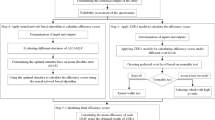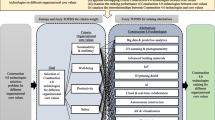Abstract
This article utilizes balanced score card (BSC) and resilience engineering factors for organizational performance. The methodology involves two stages: in the first stage, we tried to find the efficiency of organization based on previous projects of the organization applying data envelopment analysis (DEA). In order to apply DEA model for organizational assessment, some questionnaires have been spread among managers of the organization. Principal component analysis (PCA) is introduced in the second stage to highlight the shaping factors that influence overall efficiency. Furthermore, a comparison will be made with sensitivity analysis of DEA and PCA results. The results of the comparison highlight the importance of the three categories (BSC, RE, and sustainability) on organizational performance. After identifying the shaping factors and assessing the organization’s situation, artificial neural network (ANN) is applied to help us find the success factor (utility) of future projects and a mathematical formulation is presented which helps the decision makers select the best projects considering organizational situation and values. According to results, resilience engineering factors, including flexibility, management commitment, reporting culture, learning, awareness, preparedness, teamwork, redundancy, self-organization, and fault tolerance, are the most shaping and decisive factors in organization efficiency. The importance of RE over environmental factors and the coverage of data made by RE factors indicate that this construction environment devoted a great deal of attention to RE factors.







Similar content being viewed by others
References
Abimbola, M., & Khan, F. (2019). Resilience modeling of engineering systems using dynamic object-oriented Bayesian network approach. Computers & Industrial Engineering, 130, 108–118.
Andersen, P., & Petersen, N. C. (1993). A procedure for ranking efficient units in data envelopment analysis. Management Science, 39(10), 1261–1264.
Azadeh, A., Salehi, V., Ashjari, B., & Saberi, M. (2014). Performance evaluation of integrated resilience engineering factors by data envelopment analysis: The case of a petrochemical plant. Process Safety and Environmental Protection, 92(3), 231–241.
Baccarini, D., & Archer, R. (2001). The risk ranking of projects: A methodology. International Journal of Project Management, 19(3), 139–145.
Bakhshi, J., Ireland, V., & Gorod, A. (2016). Clarifying the project complexity construct: Past, present and future. International Journal of Project Management, 34(7), 1199–1213.
Banker, R. D., Charnes, A., & Cooper, W. W. (1984). Some models for estimating technical and scale inefficiencies in data envelopment analysis. Management Science, 30(9), 1078–1092.
Banker, R. D., & Morey, R. C. (1986). Efficiency analysis for exogenously fixed inputs and outputs. Operations Research, 34(4), 513–521.
Cai, B., Xie, M., Liu, Y., Liu, Y., & Feng, Q. (2018). Availability-based engineering resilience metric and its corresponding evaluation methodology. Reliability Engineering & System Safety, 172, 216–224.
Callaghan, E. G., & Colton, J. (2008). Building sustainable & resilient communities: A balancing of community capital. Environment, Development and Sustainability, 10(6), 931–942.
Charnes, A., Cooper, W. W., & Rhodes, E. (1978). Measuring the efficiency of decision making units. European Journal of Operational Research, 2(6), 429–444.
Cinque, M., Coronato, A., Testa, A., & Di Martino, C. (2013). A survey on resiliency assessment techniques for wireless sensor networks. Paper presented at the Proceedings of the 11th ACM international symposium on Mobility management and wireless access.
Cook, W. D., Liang, L., Zha, Y., & Zhu, J. (2009). A modified super-efficiency DEA model for infeasibility. Journal of the Operational Research Society, 60(2), 276–281.
Elbanna, S. (2016). Managers’ autonomy, strategic control, organizational politics and strategic planning effectiveness: An empirical investigation into missing links in the hotel sector. Tourism Management, 52, 210–220.
Ghasemi, S., Aghsami, A., & Rabbani, M. (2020). Data envelopment analysis for estimate efficiency and ranking operating rooms: A case study. International Journal of Research in Industrial Engineering, 10(1), 67–86.
Ghosh-Dastidar, S., & Adeli, H. (2009). A new supervised learning algorithm for multiple spiking neural networks with application in epilepsy and seizure detection. Neural Networks, 22(10), 1419–1431.
Ghouchani, M., Taji, M., Roshan, A. Y., & Chehr, M. S. (2020). Identification and assessment of hidden capacities of urban resilience. Environment, Development and Sustainability: A Multidisciplinary Approach to the Theory and Practice of Sustainable Development, 23(3), 1–28.
Gladwin, T. N., Kennelly, J. J., & Krause, T. S. (1995). Shifting paradigms for sustainable development: Implications for management theory and research. Academy of Management Review, 20(4), 874–907.
Greer, C. R., Lusch, R. F., & Hitt, M. A. (2017). A service perspective for human capital resources: A critical base for strategy implementation. Academy of Management Perspectives, 31(2), 137–158.
Hitt, M. A., Jackson, S. E., Carmona, S., Bierman, L., Shalley, C. E., & Wright, M. (2017). The imperative for strategy implementation. The Oxford Handbook of Strategy Implementation, 1–20.
Hollnagel, E. (2017). Safety-II in practice: developing the resilience potentials. UK: Routledge.
Hu, B., Meng, C., Xu, D., & Son, Y.-J. (2018). Supply chain coordination under vendor managed inventory-consignment stocking contracts with wholesale price constraint and fairness. International Journal of Production Economics, 202, 21–31.
Kaplan, R. S., & Norton, D. P. (1996). Using the balanced scorecard as a strategic management system. In: Harvard business review Boston.
Kaplan, R. S., & Norton, D. P. (1995). Putting the balanced scorecard. Performance Measurement, Management, and Appraisal Sourcebook, 66, 66–74.
Kaplan, R. S., Robert, N. P. D. K. S., Davenport, T. H., Kaplan, R. S., & Norton, D. P. (2001). The strategy-focused organization: How balanced scorecard companies thrive in the new business environment. Brighton: Harvard Business Press.
Kharwar, P. K., & Verma, R. K. (2020). Machining performance optimization in drilling of multiwall carbon nano tube/epoxy nanocomposites using GRA-PCA hybrid approach. Measurement, 158, 107701.
Labiad, N., Beidouri, Z., & Bouksour, O. (2012). Evaluation of coordination contracts for a two stage Supply Chain under price dependent demand. International Journal of Computer Science Issues (IJCSI), 9(1), 151.
Liu, C.-L., Shang, K.-C., Lirn, T.-C., Lai, K.-H., & Lun, Y. V. (2018). Supply chain resilience, firm performance, and management policies in the liner shipping industry. Transportation Research Part a: Policy and Practice, 110, 202–219.
Liu, X., Xu, Q., & Xu, L.-X. (2015). A Literature Review on Supply Chain Contracts Selection and Coordination under Competing Multi Manufacturers. International Journal of Business and Management, 10(7), 196.
Luo, L., He, Q., Xie, J., Yang, D., & Wu, G. (2017). Investigating the relationship between project complexity and success in complex construction projects. Journal of Management in Engineering, 33(2), 04016036.
Martin, J. A., & Eisenhardt, K. M. (2010). Rewiring: Cross-business-unit collaborations in multibusiness organizations. Academy of Management Journal, 53(2), 265–301.
Mohammadnazari, Z., & Ghannadpour, S. F. (2018). Employment of multi criteria decision making techniques and mathematical formulation for Construction of the sustainable hospital. International Journal of Hospital Research, 7(2), 112–127.
Mohammadnazari, Z., & Ghannadpour, S. F. (2021). Sustainable construction supply chain management with the spotlight of inventory optimization under uncertainty. Environment, Development and Sustainability, 23(7), 10937–10972.
Mrówczyńska, M., Sztubecki, J., & Greinert, A. (2020). Compression of results of geodetic displacement measurements using the PCA method and neural networks. Measurement, 158, 107693.
Nemeth, C. P., & Herrera, I. (2015). Building change: Resilience Engineering after ten years. Reliability Engineering & System Safety, 141, 1–4.
Nga, T. T., & Trang, T. T. (2020). Sustainability and balanced scorecard: The case of small and medium enterprise in Vietnam.
Pawar, B., Park, S., Hu, P., & Wang, Q. (2020). Applications of resilience engineering principles in different fields with a focus on industrial systems: A literature review. Journal of Loss Prevention in the Process Industries, 69, 104366.
Peñaloza, G. A. (2020). A framework to assess safety performance measurement systems for construction projects based on the resilience engineering perspective.
Rees, C. S., Breen, L. J., Cusack, L., & Hegney, D. (2015). Understanding individual resilience in the workplace: The international collaboration of workforce resilience model. Frontiers in Psychology, 6, 73.
Rezaei, A., Aghsami, A., & Rabbani, M. (2021). Supplier selection and order allocation model with disruption and environmental risks in centralized supply chain. International Journal of System Assurance Engineering and Management, 12(6), 1–37.
Rijpma, J. A. (1997). Complexity, tight–coupling and reliability: Connecting normal accidents theory and high reliability theory. Journal of Contingencies and Crisis Management, 5(1), 15–23.
Ruiz-Benítez, R., López, C., & Real, J. C. (2018). The lean and resilient management of the supply chain and its impact on performance. International Journal of Production Economics, 203, 190–202.
Russel, S., & Norvig, P. (2013). Artificial intelligence: a modern approach. New York: Pearson Education Limited.
Saavedra, J. A. (2016). An effective and optimal quality control approach for green energy manufacturing using design of experiments framework and evolutionary algorithm: The University of Texas at El Paso.
Salehi, V., Veitch, B., & Musharraf, M. (2020). Measuring and improving adaptive capacity in resilient systems by means of an integrated DEA-Machine learning approach. Applied Ergonomics, 82, 102975.
Salem, D. A., Reischl, T. M., Gallacher, F., & Randall, K. W. (2000). The role of referent and expert power in mutual help. American Journal of Community Psychology, 28(3), 303–324.
Scholten, K., & Schilder, S. (2015). The role of collaboration in supply chain resilience. Supply Chain Management: An International Journal, 20(4), 471–484.
Schröder, M., Falk, B., & Schmitt, R. (2015). Evaluation of cost structures of additive manufacturing processes using a new business model. Procedia CIRP, 30, 311–316.
Serrano Cinca, C., Mar Molinero, C., & Chaparro García, F. (1970). Behind DEA efficiency in financial institutions.
Shahtaheri, Y., Flint, M. M., & Jesús, M. (2019). A multi-objective reliability-based decision support system for incorporating decision maker utilities in the design of infrastructure. Advanced Engineering Informatics, 42, 100939.
Shirali, G. A., Mohammadfam, I., & Ebrahimipour, V. (2013). A new method for quantitative assessment of resilience engineering by PCA and NT approach: A case study in a process industry. Reliability Engineering & System Safety, 119, 88–94.
Smith, P., Hutchison, D., Sterbenz, J. P., Schöller, M., Fessi, A., Karaliopoulos, M., & Plattner, B. (2011). Network resilience: A systematic approach. IEEE Communications Magazine, 49(7), 88–97.
Tavakkoli-Moghaddam, R., Alipour-Vaezi, M., & Mohammad-Nazari, Z. (2020). A New Application of Coordination Contracts for Supplier Selection in a Cloud Environment. Paper presented at the IFIP International Conference on Advances in Production Management Systems.
Tseng, M. L. (2009). Application of ANP and DEMATEL to evaluate the decision-making of municipal solid waste management in Metro Manila. Environmental Monitoring and Assessment, 156(1–4), 181–197.
Tseng, M. L., Lin, Y. H., Chiu, A. S., & Liao, J. C. H. (2008). Using FANP approach on selection of competitive priorities based on cleaner production implementation: a case study in PCB manufacturer. Taiwan. Clean Technologies and Environmental Policy, 10(1), 17–29.
Urken, A. B., & Schuck, T. M. (2012). Designing evolvable systems in a framework of robust, resilient and sustainable engineering analysis. Advanced Engineering Informatics, 26(3), 553–562.
Wachs, P., & Saurin, T. A. (2018). Modelling interactions between procedures and resilience skills. Applied Ergonomics, 68, 328–337.
Wreathall, J. (2006). Properties of resilient organizations: an initial view, resilience engineering: concepts and precepts. resilience engineering: concepts and precepts (pp. 275–286). UK: Ashgate Aldershot.
Wreathall, J. (2017). Properties of resilient organizations: an initial view. Resilience Engineering (pp. 275–285). Florida: CRC Press.
Yarveisy, R., Gao, C., & Khan, F. (2020). A Simple yet Robust Resilience Assessment Metrics. Reliability Engineering & System Safety, 197, 106810.
Yu, D. J., Schoon, M. L., Hawes, J. K., Lee, S., Park, J., Rao, P. S. C., & Ukkusuri, S. V. (2020). Toward general principles for resilience engineering. Risk Analysis, 40(8), 1509–1537.
Author information
Authors and Affiliations
Corresponding author
Additional information
Publisher's Note
Springer Nature remains neutral with regard to jurisdictional claims in published maps and institutional affiliations.
Appendix A
Appendix A
Data generated for comparative analysis can be indicated in Table 17.
Rights and permissions
About this article
Cite this article
Mohammadnazari, Z., Aghsami, A. & Rabbani, M. A hybrid novel approach for evaluation of resiliency and sustainability in construction environment using data envelopment analysis, principal component analysis, and mathematical formulation. Environ Dev Sustain 25, 4453–4490 (2023). https://doi.org/10.1007/s10668-022-02210-z
Received:
Accepted:
Published:
Issue Date:
DOI: https://doi.org/10.1007/s10668-022-02210-z




